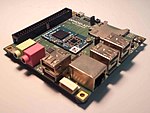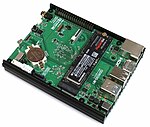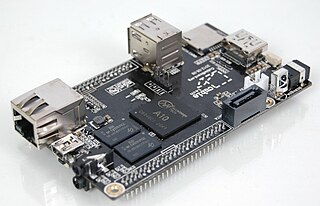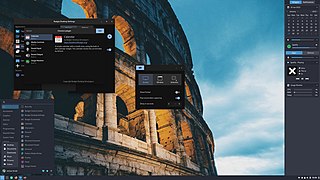| Name | Image | Year | Main SoC | CPU | GPU | RAM | Storage | USB | Video out | Audio in | Audio out | Network | Peripherals | Power source | PCB size | OS |
|---|
| ODROID | | 2009 | Samsung S5PC100 | 833 MHz, ARM Cortex-A8 | | 512 MB DDR2 | 2 GB microSD, 8 GB SDHC | USB, battery charging, serial port for system monitoring | standard type-C HDTV | Mic | 3.5mm jack | Marvell 8686 & CSR BC4-ROM | 3-axis acceleration sensor | | | Android v2.1 |
|---|
| ODROID-U2 | | 2012 [4] | Samsung Exynos 4412 | quad-core ARM Cortex-A9 @ 1.7 GHz | Mali-400 MP4 quad-core 440 MHz | 2 GB DDR2 | microSD card slot, eMMC module socket | 2 × USB A Host, 1 × ADB/Mass storage (micro USB) | Micro HDMI connector | | 3.5 mm jack and HDMI | 10/100 Ethernet (8P8C) | | 5 V 2 A DC input (2.5 x 0.8 mm barrel connector) | 48 × 52 mm | Android, Ubuntu, Arch Linux [5] |
|---|
| ODROID-X2 |  | 2012 | SD card slot, eMMC module socket | 6 × USB A Host, 1 × ADB/Mass storage (Micro USB) | Micro HDMI connector, RGB 24-bit LCD interface port | Mic | expansion ports for GPIO, UART, I²C, SPI bus, ADC and LCD | 90 × 94 mm | Android, Ubuntu |
|---|
| ODROID-U3 | | 2014 | Samsung Exynos 4412 Prime | quad-core ARM Cortex-A9 @ 1.7 GHz | Mali-400 MP4 quad-core 533 MHz | 2 GB LPDDR2 PoP (Package on Package) | microSD card slot, eMMC module socket | 3 × USB 2.0 A Host 1 x USB 2.0 ADB/Mass Storage (Micro USB) | Micro HDMI connector | | 3.5 mm jack and HDMI | 10/100 Ethernet (8P8C) | expansion ports for GPIO, UART, I²C, SPI bus, PWM ADC and LCD | 5 V 2 A DC input (2.5 x 0.8 mm barrel connector) | 83 × 48 mm | Android, Ubuntu, Arch Linux [6] |
|---|
| ODROID-XU | | 2013 | Samsung Exynos 5410 Octa | big.LITTLE ARM Cortex-A15 @ 1.6 GHz quad-core and ARM Cortex-A7 @ 1.2 GHz quad-core CPUs | PowerVR SGX544MP3 (OpenGL ES 2.0, OpenGL ES 1.1, and OpenCL 1.1 EP) | 2 GB LPDDR3 PoP (Package on Package) | microSD card slot, eMMC 4.5 module socket | 4 × USB 2.0 A Host 1 x USB 3.0 Host, 1 x USB 3.0 OTG | Micro HDMI connector 1.4a output Type-D, MIPI DSI and touchscreen I²C ports | | 3.5 mm jack and HDMI | 10/100 Ethernet (8P8C) | expansion ports for GPIO, UART, I²C, SPI bus, PWM ADC and LCD | 5 V 4 A DC input (5.5 x 2.1 mm barrel connector) | 94 × 70 × 18 mm | Android, Ubuntu |
|---|
| ODROID-XU3/XU3-Lite | | 2014 | Samsung Exynos 5422 Octa | big.LITTLE ARM Cortex-A15 @ 2.0 GHz (Lite @ 1.8 GHz) quad-core and Cortex-A7 quad-core CPUs | Mali-T628 MP6 (OpenGL ES 3.0/2.0/1.1 and OpenCL 1.1 Full profile) | 2 GB LPDDR3 RAM at 933 MHz (14.9 GB/s memory bandwidth) PoP stacked | microSD card slot, eMMC5.0 HS400 Flash Storage | 4 × USB 2.0 A Host 1 x USB 3.0 Host, 1 x USB 3.0 OTG | Micro HDMI connector 1.4a output Type-D, Integrated power consumption monitoring tool | | 3.5 mm jack and HDMI | 10/100 Ethernet (8P8C) | expansion ports for GPIO, UART, I²C, SPI bus, PWM ADC and LCD | 5 V 4 A DC input (5.5 x 2.1 mm barrel connector) | 94 × 70 × 18 mm | Android, Ubuntu |
|---|
ODROID-W [7]
(discontinued) (W for Wearable computer) | | 2014 | Broadcom BCM2835 | ARM11 @ 700 MHz | Broadcom VideoCore IV | 512 MB DDR2 SDRAM | microSD card slot, eMMC module socket | 1 x USB 2.0 Host | Micro HDMI connector 1.4a output Type-D | | | | expansion ports for GPIO, MIPI input for camera, PWM ADC and real-time clock | 5 V input from Micro-USB socket | 60 x 36 mm | |
|---|
| ODROID-C1 [8] | | 2014 | Amlogic S805 | 4× Cortex-A5 @ 1.5 GHz | Mali-450 MP2 | 1 GB DDR3 SDRAM | microSD card slot, eMMC module socket | 4× USB 2.0 Host, 1× USB 2.0 OTG | Micro HDMI connector Type-D | — | — | 10/100/1000 Ethernet (8P8C) | expansion ports for console UART, IR receiver, GPIO, I²C, SPI, ADC | 5 V 2 A DC input (2.5 x 0.8 mm barrel connector) | 85 × 56 mm | Linux, Android |
|---|
| ODROID-C1+ [8] | | 2015 | standard HDMI connector Type-A | 5 V input from Micro-USB socket |
|---|
| ODROID-XU4 [9] | | 2015 | Samsung Exynos 5422 | big.LITTLE ARM Cortex-A15 @ 2.0 GHz quad-core and ARM Cortex-A7 quad-core CPUs (ARMv7-A 32bit) | Mali-T628 MP6 (OpenGL ES 3.0/2.0/1.1 and OpenCL 1.1 Full profile) | 2 GB LPDDR3 RAM at 933 MHz (14.9 GB/s memory bandwidth) PoP stacked | microSD card slot, eMMC5.0 HS400 Flash Storage | 1 × USB 2.0 A Host 2 x USB 3.0 Host | HDMI connector 1.4a output Type-A | | HDMI | 10/100/1000 Ethernet (8P8C) | expansion ports for GPIO, UART, I²C, I²S, SPI bus, PWM ADC | 5 V 4 A DC input (5.5 x 2.1 mm barrel connector) | 83 x 59 x 18 mm | Linux (Ubuntu, Kali Linux, [10] DietPi [11] ), Android |
|---|
| ODROID-C2 [12] | | 2016 | Amlogic S905 | ARM Cortex-A53 (ARMv8 64bit) quad-core @ 1.5 GHz | Mali-450 MP3 (3 Pixel +2 Vertex Shader) triple-core | 2 GB DDR3 SDRAM at 912 MHz | microSD card slot, eMMC module socket | 4× USB 2.0 Host | Type-A HDMI 2.0 4K/60 Hz | — | HDMI | 10/100/1000 Ethernet (8P8C) | expansion ports for console UART, IR receiver, 40× GPIO, I²C, ADC | 5 V 2 A DC input (2.5 x 0.8 mm barrel connector) | 85 × 56 mm | Linux (Ubuntu, [13] Arch Linux, [14] DietPi [11] ), Android [15] |
|---|
| ODROID-H2 [16] |  | 2018 | Intel Celeron J4105 | 2.3 GHz Quad-core x86_64 processor [17] | Intel UHD Graphics (Gen9.5) 600 (GT1) 700 Mhz | Dual-channel Memory DDR4-PC19200 (up to 32 GB) | 2 x SATA 3.0 eMMC5.1 | 2x USB 2.0 2x USB 3.0 Host | 1 x DisplayPort 1.2 (up to 4K@60 Hz) 1 x HDMI 2.0 (up to 4K@60 Hz) | | | 2x 10/100/1000 Ethernet | | 14V ~ 20V 4A DC (5.5 x 2.1 mm barrel connector) | 110x110x43mm | Ubuntu 18.10 |
|---|
| ODROID-N2 [18] | | 2019 | Amlogic S922X | quad-core ARM Cortex-A73 (ARMv8-A, 1.8 GHz) and dual-core ARM Cortex-A53 (ARMv8-A, 1.9 GHz) | Mali-G52 GPU with 6 x Execution Engines (846 Mhz) | DDR4 4GiB or 2 GiB with 32-bit bus width | eMMC5.1 microSD | 4 x USB 3.0 Host 1 x USB 2.0 OTG port for Host or Device mode | 1 x HDMI 2.0 (up to 4K@60 Hz with HDR, CEC, EDID) 1 x Composite video (on 3.5mm TRRS jack) | | Stereo audio up to 384 kHz (on 3.5mm TRRS jack) | 1 x GbE Ethernet (RJ45, supports 10/100/1000 Mbit/s) | expansion ports for console UART, IR receiver, 40× GPIO, I²C, ADC | DC 12V ~ 15V (up to 2A) (5.5 x 2.1 mm barrel connector) | Board: 90mm x 90mm x 17mm Heatsink: 100mm x 91mm x 25mm | Ubuntu 18.04 LTS Android 9 Pie DietPi [11] |
|---|
| ODROID-N2+ [19] | | 2020 | Amlogic S922X | Quad-core ARM Cortex-A73 (ARMv8-A, 2.4 GHz) and dual-core ARM Cortex-A53 (ARMv8-A, 2.0 GHz) | Mali-G52 GPU with 6 x Execution Engines (800 MHz) | DDR4 4GiB or 2 GiB with 32-bit bus width | eMMC5.1 microSD | 4 x USB 3.0 Host (shares one single root hub) 1 x USB 2.0 OTG port for Host or Device mode | 1 x HDMI 2.0 (up to 4K@60 Hz with HDR, CEC, EDID) 1 x Composite video (on 3.5mm TRRS jack) | | Stereo audio up to 384 kHz (on 3.5mm TRRS jack) | 1 x GbE Ethernet (RJ45, supports 10/100/1000 Mbit/s) | expansion ports for console UART, IR receiver, 40× GPIO, I²C, ADC | DC 7.5V ~ 18V (up to 25W) (5.5 x 2.1 mm barrel connector) | Board: 90mm x 90mm x 17mm Heatsink: 100mm x 91mm x 18.75mm | Ubuntu 20.04 LTS Android 9 Pie |
|---|
| ODROID-C4 [20] | | 2020 | Amlogic S905X3 | quad-core Cortex-A55 (ARMv8-A, 2.0 GHz) | Mali-G31 GPU MP2 (650 Mhz) | DDR4 4GiB with 32-bit bus width | eMMC5.1 microSD | 4 x USB 3.0 Host 1 x USB 2.0 OTG port for Host or Device mode | 1 x HDMI 2.0 (up to 4K@60 Hz with HDR, CEC, EDID) | | | 1 x GbE Ethernet (RJ45, supports 10/100/1000 Mbit/s) | expansion ports for console UART, IR receiver, 40× GPIO, I²C, ADC | DC 7.5V ~ 17V (up to 25W) (5.5 x 2.1 mm barrel connector) | Board: 85mm x 56mm x 1.0mm Heatsink: 40mm x 32mm x 10mm | Ubuntu 18.04 LTS Android 9 Pie DietPi [11] |
|---|
| ODROID-HC4 [21] | | 2020 | Amlogic S905X3 | Quad-core Cortex-A55 (ARMv8-A, 1.8 GHz) | Mali-G31 GPU MP2 (650 MHz) | DDR4 4GiB with 32-bit bus width 2640 MT/s (PC4-21333 grade) | 2 x SATA microSD | 1 x USB 2.0 Host | 1 x HDMI 2.0 (up to 4K@60 Hz with HDR, CEC, EDID) | | | 1 x GbE Ethernet (RJ45, supports 10/100/1000 Mbit/s) | expansion ports for console UART, IR receiver, 5× GPIO | DC 14.5V ~ 15.5V (5.5 x 2.1 mm barrel connector) | Board: 84mm x 90.5mm x 25.0mm Heatsink: 40mm x 32mm x 10mm | Ubuntu 18.04 LTS |
|---|
| ODROID-H2+ [22] | | 2020 | Intel Celeron J4115 | 2.3 GHz Quad-core x86_64 processor [17] | Intel UHD Graphics (Gen9.5) 600 (GT1) 700 Mhz | Dual-channel Memory DDR4-PC19200 (up to 32 GB) | 2 x SATA 3.0 eMMC5.1 m.2 nvme | 2x USB 2.0 2x USB 3.0 Host | 1 x DisplayPort 1.2 (up to 4K@60 Hz) 1 x HDMI 2.0 (up to 4K@60 Hz) | | S/PDIF out 3.5mm out | 2x 10/100/1000/2500 Ethernet | expansion ports for console UART, 24× GPIO | 14V ~ 20V 4A DC (5.5 x 2.1 mm barrel connector) | 110x110x47mm | Ubuntu 20.04 LTS Windows |
|---|
| ODROID-H3 [23] /H3+ [24] | | 2022 | Intel Celeron N5105 (H3) Intel Celeron N6005 (H3+) | 2.9 GHz Quad-core x86_64 processor (H3) 3.3 GHz Quad-core x86_64 processor (H3+) | Intel UHD Graphics 24/32 EU up to 900 MHz | Dual-channel Memory DDR4-PC23400 (up to 64 GB) | 2 x SATA 3.0 eMMC M.2 NVMe | 2x USB 2.0 Host 2x USB 3.0 Host | 1 x DisplayPort 1.2 (up to 4K@60 Hz) 1 x HDMI 2.0 (up to 4K@60 Hz) | | S/PDIF out 3.5mm out | 2x 10/100/1000/2500 Ethernet | expansion ports for console UART, 24× GPIO | 14V ~ 20V 4A DC (5.5 x 2.1 mm barrel connector) | 110x110x47mm | |
|---|
| ODROID-M1 [25] |  | 2022 | Rockchip RK3568B2 | 1.992 GHz quad-core ARM Cortex-A55 processor | Mali-G52 MP2 graphics | 8GB of LPDDR4 DRAM | 1 x SATA 3.0 eMMC5.1 microSD 42mm M.2 NVMe (PCIe M-key) | 2x USB 2.0 Host 2x USB 3.0 Host | 1 x HDMI 2.0 (up to 4K@60 Hz) 1 x MIPI-DSI LCD Interface (31 pin) | | 3.5mm out, mono speaker out, HDMI | 1x 10/100/1000 Ethernet | expansion ports for console UART, 24× GPIO | DC 7.5V ~ 17V (up to 25W) (5.5 x 2.1 mm barrel connector) | 122x90x16mm | |
|---|
| ODROID-N2L [26] | | 2022 | Amlogic S922X | Quad-core ARM Cortex-A73 (ARMv8-A, 2.2 GHz) and dual-core ARM Cortex-A53 (ARMv8-A, 2.0 GHz) | Mali-G52 GPU with 6 x Execution Engines (800 MHz) | LPDDR4 4GiB or 2 GiB with 32-bit bus width | eMMC5.1 microSD | 1 x USB 3.0 Host 1 x USB 2.0 Host | 1 x HDMI 2.0 (up to 4K@60 Hz with HDR, CEC, EDID) | | | | expansion ports for console UART, 40× GPIO, I²C, ADC | DC 7.5V ~ 16V (5.5 x 2.1 mm barrel connector) | Board: 69mm x 56mm x 22mm Heatsink: 100mm x 91mm x 18.75mm | Ubuntu 20.04 LTS Android 9 Pie EmuELEC (TBD) |
|---|
| Name | Image | Year | Main SoC | CPU | GPU | RAM | Storage | USB | Video out | Audio in | Audio out | Network | Peripherals | Power source | PCB size | OS |
|---|
















